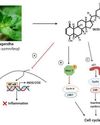CATEGORIES
Kategorien

A soybean protein blocks LDL cholesterol production, reducing risks of metabolic diseases
Consuming soy flour rich in the protein B-conglycinin has the potential to reduce LDL Ci cholesterol levels and lower the risk of metabolic diseases such as atherosclerosis and fatty liver disease, said Elvira de Mejia, a professor of food science and human nutrition at the University of Illinois Urbana-Champaign and the corresponding author of the study.

Gympie Gympie: suicide plant which causes thoughts of suicide
The stinging bush, a member of the nettle family (Urticaceae), gets its name after the Australian town of Gympie, a gold mining hub settled in the 1860s.

Genome and Genome Sequencing Technologies
Genome is the vital genetic information of all living beings and being able to decode this genome had been an enduring wish for biologists and geneticists alike.

LUBE-TIPS
The \"Lube-Tips\" section of Machinery Lubrication magazine features innovative ideas submitted by our readers.

The Future of Mobility - Klüber Lubrication
Klüber Lubrication showcased their state of the art solutions at the Auto Expo Components 2023 (January 12th to 15th, Pragati Maidan, New Delhi).

How Important is Oil Level Control in Optimizing Bearing, Gear and Engine Reliability?
Often times in machinery lubrication, we preach precision lubrication. What exactly does that mean?

Must be Something in the Water: Aqueous Toxicity
ENERGY CONSERVATION, HEALTH & ENVIRONMENT

How to Sell a Lube Program to Plant Management: In a Word - Creditability
\"Creditability goes beyond what people say to sell us on ideas by adding past performance to predict future performance. Creditability is therefore earned.\"

RATIONALIZATION OF LAB TESTS FOR MEASUREMENT OF INSOLUBLE CONTAMINANTS IN LUBE OIL
\"The lube oil degradation can be the result of both physical and chemical actions\"

Supply Chain Crisis: Ensure That You Have the Right Lubricants on Hand
With many disruptions in the supply chain in the recent past, it is becoming commonplace for lubricants to have longer lead times, and in some cases, lubricants may not be available at all.

Five Common Mistakes Made when Developing an Inspection Route
Developing and implementing inspection routes is a key part of a successful lubrication program.

Particle Counting: Why Smaller Particles Lead to Big Trouble
CONDITION MONITORING, LUBRICANT ANALYSIS AND TROUBLESHOOTING

Aeration and Foam: Good for Beer, Bad for Oil
CONTAMINATION CONTROL & LUBRICANT RECONDITIONING

AN INTRODUCTION TO KASHYAPA HORA NADI PRASNA - PART - 3 OF 3
TOOLS & TECHNIQUES

JUPITER WITH RAHU IN ARIES IN 2023
Effects on All Signs

GURU CHANDALA YOGA AND PROSPECTS FOR THE UPCOMING YEAR
MUNDANE ASTROLOGY

GURU CHANDALA YOGA EFFECTS AND REMEDIES
GURU CHANDALA YOGA

THE GURU CHANDALA YOGA OF 2023
Bangalore Niranjan Babu

MALAYSIAN GENERAL ELECTION 2022 IN THE MIDST OF RETROGRADE MARS IN MARGASIRSHA (ORION -THE HUNTER)
Malaysia polls as retrograde Mars touch the Independence Ascendant 8:04

Plastic Pollution - Discord From The Beginning
Industry hijacks the first round of negotiations on proposed global plastic treaty as countries talk in differing voices

'This rocket launch will inspire youngsters to join the space sector'
On November 18, 2022, Hyderabad-based Skyroot Aerospace Pvt Ltd scripted history by becoming the first private Indian organisation to launch a rocket from Indian Space Research Organisation's (ISRO's) launchpad in Sriharikota, Andhra Pradesh. The launch of the rocket, named Vikram-S after Indian space scientist Vikram Sarabhai, was successful. In a conversation with ROHINI KRISHNAMURTHY, Skyroot Aerospace co-founder PAWAN KUMAR CHANDANA talks about the company's plans to establish itself as satellite launcher catering to the international market and the long-term goal of developing resuable rockets to ensure sustainabililty. Excerpts:

Killed in cold blood
Surveys quantify the impact of crop intensification on frogs and reptiles; say loss of species and farm productivity inevitable

Battle half won
Lula's return as president speaks of his appeal with Brazil's poorest people. But this time the country is bitterly divided and short on cash

Fighting chance
The new framework on biodiversity provides the opportunity for a fresh start, but countries must ensure implementation

Barely a contrast
WALKING FROM DANDI: IN SEARCH OF VIKAS IS YET ANOTHER HAGIOGRAPHY OF M K GANDHI THAT UNCRITICALLY ROMANTICISES AND MYTHOLOGISES THE HISTORICAL FIGURE

FAKE FABRIC
The moment you consider polyester just a fabric, it escapes attention as a pollutant. The fact is that polyester is a form of plastic and the second biggest by-product of petrochemicals. Yet only a few countries have regulations to manage the plastic fibre. Time India framed laws to regulate the textile industry and brought it under the extended producer responsibility regime

Planting monopolies in farm sector
The EU free trade deal may force India to jettison farmers’ traditional rights in favour of breeders’ interests

DEEP INVASION
Invasive ornamental shrub lantana is altering traits, fast spreading across India's forests

Are We Living In A Simulation?
We humans are not capable enough to understand and experience the exact nature of the universe, unfiltered. Due to several biological and physical limitations of our sense organs and brain we only process a small fraction of the universe.

Ashwagandha: A Potential Source For Cancer Therapeutics
Several ayurvedic plants have been reported to possess cancer preventive and chemotherapeutic potential.